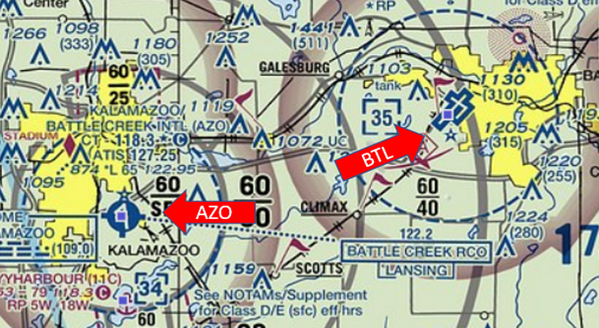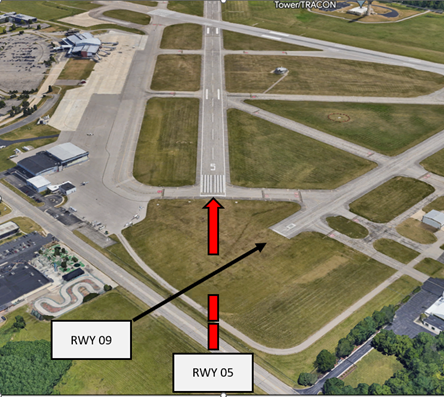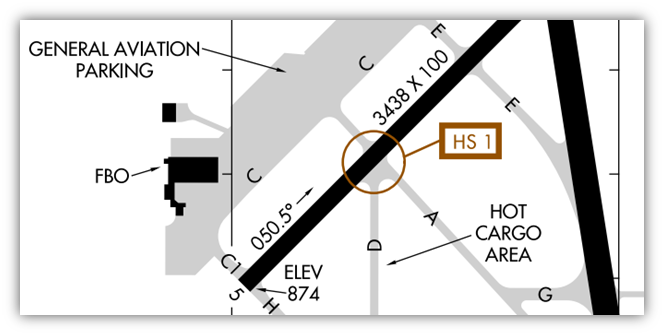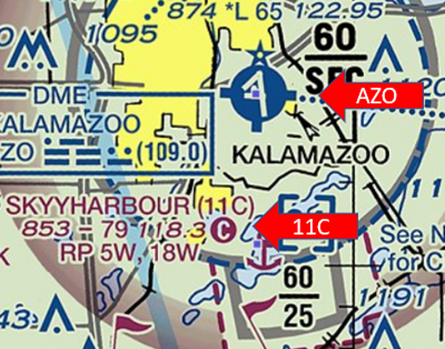Kalamazoo/Battle Creek International Airport (AZO)
Kalamazoo/Battle Creek International Airport (AZO) is a medium sized, multi-use airport located on the southeast edge of the city of Kalamazoo, Michigan. While AZO is served by several air carriers, the bulk of the traffic is made up of general and corporate aviation aircraft. This diverse mix of pilot experience and aircraft capability require increased attention when flying to this airport, especially if it's your first time there. View a printable Pilot Handbook of the AZO information found on this Web page.
Know Before You Go
- The runway configuration consists of one large runway RWY 17/35 and two smaller runways RWY 05/23 and RWY 09/27.
- Both smaller RWYs intersect the larger RWY 17/35.
The airspace at AZO is Class D with a 3,400’ MSL ceiling. It underlies the Kalamazoo TRSA.
(Refer to Sectional Chart) Also, see additional information for TRSA information.
Below find various AZO-specific information and things to be aware of, as well as general information to inform your preflight planning. This will be reviewed quarterly and updated as needed. This information is to supplement the From the Flight Deck Videos that are produced by the FAA Runway Safety Group. Here you will also find information provided by the local air traffic controllers at the airport where you intend to fly. The information is subject to change. Not for navigation or legal* pre-flight action. Always refer to official pre-flight materials such as, but not limited to, NOTAMs, airport diagrams, VFR charts and airport construction notices for the latest airport-specific details.
AZO Tower Operates 0700L to 2400L - Daily
Administrative Office Open 0800L to 1600L – M through F
Business Phone 269-459-3351
Hot Spots
HS 1 Complex intersection of RWY 05, TWY A and TWY D.
Departure
- Verify correct RWY and compass heading prior to starting takeoff roll on all intersection and full-length departures.
Landing
- Wrong Airport Landing risk exists here.
- Fifteen miles east of AZO is Battle Creek Executive at Kellogg Field (BTL).
- Pilots mistake BTL for AZO and vice versa.

- Wrong Surface Landing risk exists here.
- Be aware that RWY 09 and RWY 05 approach ends are closely aligned.

Surface Risk – Movement Area
- At Hot Spot 1 the geometry and the large expanse of concrete can cause confusion and potential RWY incursions.

Additional Cautions
- Migratory waterfowl roosting area 5,500’ approach end RWY 35.
- Skyyharbour Seaplane Base (11C) is located 3.6 NM south of the airport. Be aware that aircraft operating at 11C will announce intentions on AZO CTAF.

The following is local airport specific Information that your TWR Controllers want to pass along.
General
- AZO is a TRSA. If you don’t want flight following, specifically state “non-TRSA”.
[TRSA Airspace is located around areas with busy Class D airports and provide radar traffic separation.
Participation in TRSA functions is optional for VFR Pilots.
If you choose to participate in TRSA services:
You will be assigned a discrete transponder code,
Altitude and Heading assignments are mandatory.
You need a 2-way radio.
Transponder and ADS-B are not mandatory.
If ever in doubt about your position or instructions, ask the TWR.]
- Use your callsign when reading back clearances and instructions. This can greatly reduce confusion and the potential for pilot/controller errors.
Traffic Patterns
- Relay all non-standard requests to tower as soon as practical so the tower can plan.
Ground
- Multiple runway crossings may be needed to taxi to the assigned departure runway. Be extra vigilant while listening and reading back instructions. If you are unsure about your taxi clearance or position advise ground control.
Take-off/Departure
- Reading back departure control instructions ensures that the tower/pilot are both on the same page and there is no confusion.
Avoidance Areas
- Avoid transitioning through the departure end of the active runways.
Additional Information
- RWYs 05/23 and RWYs 09/27 do not have overruns.
